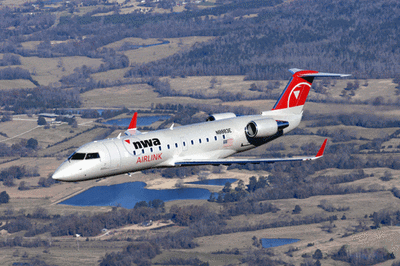Lessons To Be Learned From April 2007 Incident At TVC
 In the aftermath of the
National Transportation Safety Board's review last week of the
circumstances leading to the April 2007 runway overrun of a
Pinnacle Airlines CRJ200 at Traverse City, MI, on Tuesday the NTSB
issued three recommendations to the FAA intended to address crew
fatigue issues, and other factors which may have contributed to the
accident.
In the aftermath of the
National Transportation Safety Board's review last week of the
circumstances leading to the April 2007 runway overrun of a
Pinnacle Airlines CRJ200 at Traverse City, MI, on Tuesday the NTSB
issued three recommendations to the FAA intended to address crew
fatigue issues, and other factors which may have contributed to the
accident.
As ANN reported, on April 12,
2007, about 0043 eastern daylight time, a Bombardier/Canadair
Regional Jet (CRJ) CL600-2B19, N8905F, operated as Pinnacle
Airlines flight 4712, ran off the departure end of runway 28
following a landing in snowy weather at Cherry Capital Airport
(TVC), Traverse City, Michigan. There were no injuries among the 49
passengers and three crewmembers, though the aircraft was
substantially damaged. The airplane had departed from
Minneapolis-St. Paul International Airport (MSP) about 2153 central
daylight time (CDT).
The National Transportation Safety Board determined that the
probable cause of this accident was the pilots’ decision to
land at TVC without performing a landing distance assessment, which
was required by company policy because of runway contamination
initially reported by TVC ground operations personnel and
continuing reports of deteriorating weather and runway conditions
during the approach.
"This poor decision-making likely reflected the effects of
fatigue produced by a long, demanding duty day, and, for the
captain, the duties associated with check airman functions," the
NTSB determined.
Contributing to the accident were the FAA pilot flight and duty
time regulations that permitted the pilots’ long, demanding
duty day, and the TVC operations supervisor’s use of
ambiguous and unspecific radio phraseology in providing runway
braking information.

The NTSB determined the FAA should:
- Emphasize with principal operations inspectors the importance
of conducting timely postaccident drug and alcohol testing.
(A-08-40) (Editor's Note -- In its full report, the NTSB states
there's no reason to suspect either pilot was impaired by
alcohol... but notes due to the lack of requirements for the pilots
to be tested immediately following the accident, no determination
can be made.)
- As part of the Takeoff/Landing Performance Assessment Aviation
Rulemaking Committee, address the need for initial training on the
rationale for and criticality of conducting landing distance
assessments before landing on contaminated runways. (A-08-41)
- Issue a CertAlert to all 14 Code of Federal Regulations Part
139 certificated airports that describes the circumstances of this
accident, emphasizes the importance of specific and decisive radio
communications, and urges airports to ensure that those criteria
are being met in all airfield radio communications. (A-08-42)
- Require all 14 Code of Federal Regulations Part 139
certificated airport operators to include in their airport's snow
and ice control plan absolute criteria for type and depth of
contamination and runway friction assessments that, when met, would
trigger immediate closure of the affected runway to air carrier
operations. Friction assessments should be based on pilot braking
action reports, values obtained from ground friction measuring
equipment, or estimates provided by airport ground personnel.
(A-08-43)
The NTSB also reaffirmed its position the FAA adhere to three
previous recommendations:
-
 Evaluate crash
detection and location technologies, select the most promising
candidate(s) for ensuring that emergency responders could
expeditiously arrive at an accident scene, and implement a
requirement to install and use the equipment. (A-01-66)
Evaluate crash
detection and location technologies, select the most promising
candidate(s) for ensuring that emergency responders could
expeditiously arrive at an accident scene, and implement a
requirement to install and use the equipment. (A-01-66)
- Immediately require all 14 Code of Federal Regulations Part
121, 135, and 91 subpart K operators to conduct arrival landing
distance assessments before every landing based on existing
performance data, actual conditions, and incorporating a minimum
safety margin of 15 percent. (A-07-57) (Urgent)
- Modify and simplify the flight crew hours-of-service
regulations to take into consideration factors such as length of
duty day, starting time, workload, and other factors shown by
recent research, scientific evidence, and current industry
experience to affect crew alertness. (A-06-10)
 Airbus Racer Helicopter Demonstrator First Flight Part of Clean Sky 2 Initiative
Airbus Racer Helicopter Demonstrator First Flight Part of Clean Sky 2 Initiative Diamond's Electric DA40 Finds Fans at Dübendorf
Diamond's Electric DA40 Finds Fans at Dübendorf ANN's Daily Aero-Term (04.23.24): Line Up And Wait (LUAW)
ANN's Daily Aero-Term (04.23.24): Line Up And Wait (LUAW) NTSB Final Report: Extra Flugzeugbau GMBH EA300/L
NTSB Final Report: Extra Flugzeugbau GMBH EA300/L Classic Aero-TV: 'Never Give Up' - Advice From Two of FedEx's Female Captains
Classic Aero-TV: 'Never Give Up' - Advice From Two of FedEx's Female Captains





